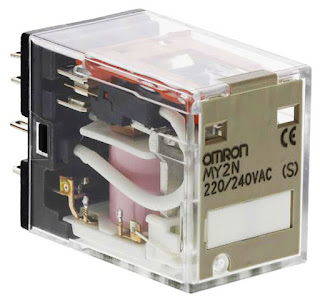Electromechanical Relays (EMRs) vs. Solid State Relays Comparison (SSRs)
Electromechanical Relays (EMR) Pros (Advantages)
• Lower initial cost compared to solid state relays.
• Provides complete electrical isolation.
• Tolerates high current & voltage transients.
• Insensitive to electromagnetic interference (EMI) / radio frequency interference (RFI).
• Higher open resistance (air gap).
• Lower closed resistance.
• Available with many poles/circuits (up to 8 or more).
• Many different circuit configurations available.
• Multiple packaging & feature options.
• Most typical failure mode is open.
Electromechanical Relays (EMR) Cons (Disadvantages)
• Higher control (coil) power consumption.
• Contact arcing can cause pitting & eventual open/short failure.
• Contacts can be affected by corrosion, oxidation or contamination.
• Contact bounce possible due to shock & vibration.
• Generates electromagnetic interference (EMI) / radio frequency interference (RFI).
• Can be orientation sensitive.
• Can be affected by external magnetic fields.
• Subject to mechanical degradation over time (residual magnetism, armature flexing, spring stretching).
• Potential higher overall cost over equipment life.
• Can be noisy.
Solid State Relays (SSR) Pros (Advantages)
• Substantially longer life compared to mechanical relays.
• Low control power consumption.
• Faster on/off cycling.
• Allows very fine proportional output control.
• No arcing (safer in hazardous environments).
• No contact bounce.
• Not orientation sensitive.
• Switching not affected by shock & vibration.
• Not affected by external magnetic fields.
• Less electromechanical interference.
• Silent operation.
• Allows many functions in a single package.
• Potentially lower overall cost over equipment life.
Solid State Relays (SSR) Cons (Disadvantages)
• Higher initial cost compared to mechanical relays.
• Generate more heat compared to mechanical relays.
• Current rating may require derating based on ambient temperature.
• Voltage or current transients can damage or affect operation.
• Susceptible to electromagnetic interference (EMI) / radio frequency interference (RFI).
• Lower off state resistance.
• Higher on state resistance.
• Most are single pole/circuit (some available with up to 4).
• Normally closed/ON function available on a limited basis.
• Changeover form/circuit not supported.
• Most typical failure mode is shorted/closed.
• Lower initial cost compared to solid state relays.
• Provides complete electrical isolation.
• Tolerates high current & voltage transients.
• Insensitive to electromagnetic interference (EMI) / radio frequency interference (RFI).
• Higher open resistance (air gap).
• Lower closed resistance.
• Available with many poles/circuits (up to 8 or more).
• Many different circuit configurations available.
• Multiple packaging & feature options.
• Most typical failure mode is open.
• Higher control (coil) power consumption.
• Contact arcing can cause pitting & eventual open/short failure.
• Contacts can be affected by corrosion, oxidation or contamination.
• Contact bounce possible due to shock & vibration.
• Generates electromagnetic interference (EMI) / radio frequency interference (RFI).
• Can be orientation sensitive.
• Can be affected by external magnetic fields.
• Subject to mechanical degradation over time (residual magnetism, armature flexing, spring stretching).
• Potential higher overall cost over equipment life.
• Can be noisy.
Solid State Relays (SSR) Pros (Advantages)
• Substantially longer life compared to mechanical relays.
• Low control power consumption.
• Faster on/off cycling.
• Allows very fine proportional output control.
• No arcing (safer in hazardous environments).
• No contact bounce.
• Not orientation sensitive.
• Switching not affected by shock & vibration.
• Not affected by external magnetic fields.
• Less electromechanical interference.
• Silent operation.
• Allows many functions in a single package.
• Potentially lower overall cost over equipment life.
Solid State Relays (SSR) Cons (Disadvantages)
• Higher initial cost compared to mechanical relays.
• Generate more heat compared to mechanical relays.
• Current rating may require derating based on ambient temperature.
• Voltage or current transients can damage or affect operation.
• Susceptible to electromagnetic interference (EMI) / radio frequency interference (RFI).
• Lower off state resistance.
• Higher on state resistance.
• Most are single pole/circuit (some available with up to 4).
• Normally closed/ON function available on a limited basis.
• Changeover form/circuit not supported.
• Most typical failure mode is shorted/closed.




Comments